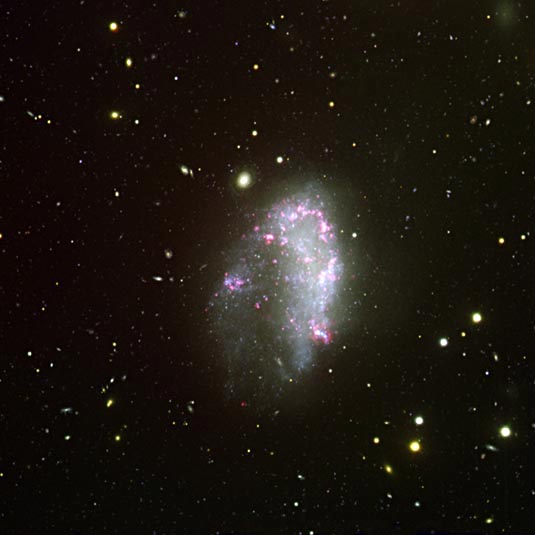
Irregular Galaxies
RA 3hr 40m 8.60s Dec -35° 37' 10.13"
Eridanus
50 million light years
13.4
2.3' × 1.5'
6.20 x 5.88 arcminutes
North is 87.1° left of vertical
ESO
July 26, 2006
Hubble 2005 Image: G0509
ABOUT THIS IMAGE:
This is an image of NGC 1427A. It is an irregular galaxy in the constellation Eridanus. It is the brightest dwarf irregular member of the Fornax cluster and is in the foreground of the cluster's central galaxy NGC 1399. Located about 60 million light-years away, NGC 1427A is about 20,000 light-years long and shares some resemblances with our neighboring Large Magellanic Cloud. NGC 1427A is in fact plunging into the Fornax cluster of galaxies at a speed of 600 km/s, and takes an arrowhead shape. Moving so rapidly, the galaxy is compressed by the intracluster gas, and this compression gives birth to many new stars.
Using these and other VLT observations, astronomer Iskren Y. Georgiev from the Argelander Institute for Astronomy at Bonn (Germany) and his colleagues were able to find 38 candidates globular clusters that are about 10 billion years old. The scientists also inferred that NGC 1427A is about 10 million light-years in front of NGC 1399. It seems certain that under such circumstances, the future of NGC 1427A looks bleak, as the galaxy will finally be disrupted, dispersing its content of gas and stars in the intracluster regions.
Just next to NGC 1427A on the upper left, but 25 times further away, a more typical, beautiful face-on spiral galaxy is looking rather unperturbed at the dramatic spectacle.
A
color composite image of NGC 1427A, based on observations collected with
FORS1 in Service mode for Andreas Reisenegger and his colleagues in November
2002 and January 2003. A very tenuous galaxy is also visible in the upper
right corner. For the blue, green and red channels the U, V and H-alpha
filters were used, respectively. North is on the left and West is up.
The entire field of view of this image is ~ 6.7 x 6.7 arcmin which corresponds
to ~ 120 x 120 thousand light-years at the Fornax Cluster distance. Henri
Boffin (ESO) did the final processing of the image